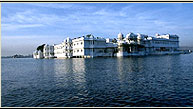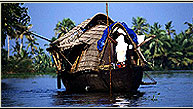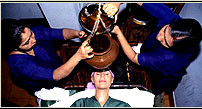-| Madurai Tour | -

Situated
on banks of river Vaigai, Madurai is one of the most illustrious and oldest
cities of South India. The name Madurai is derived from the Tamil word 'Madhuram'
which means 'sweetness' . This city is the subject of an extraordinary number
of myths. It is believed that Lord Shiva shook his matted tresses over the city
sprinkling it with "Amrit", the nectar of immortality.
Madurai is a typical Hindu City and was the capital of ancient Pandya Dynasty
till 10th Century.
The main landmarks of the city are -
Meenakshi Sundareshwara Temple
Fortified with 6 meters high wall, it is one of the largest temple complexes
in India. Meenakshi Temple was constructed between 16th to 18th Century, but,
certain parts of this temple are much older. This temple is dedicated to the
Fish-eyed Goddess Meenakshi or Parvati and Lord Shiva or Sundareshwara. The
temple has got more than 33 million sculptures and approximately 50 priests.
The entire temple complex comprises of 12 tall gopurams, out of which 4 largest
ones rise to the height of 46 meters with each gopuram is filled with intricately
carved sculptures of Gods and Demons.
The western side entrance leads to Meenakshi Shrine popularly known as Amman
Koyil , which means Mother Temple. Non - Hindus are not allowed inside this
shrine. However, they can roam about in all the other parts of the complex.
A passage in North of Meenakshi Shrine leads to the Sundareshwara Shrine.
It has got a huge monolithic figure of Lord Ganesha, which was found during
the excavation of Mariamman Teppakulam Tank.
The Northeast corner of this complex is called as Ayirakkal Mandapam or thousand
pillared hall. This hall has a fine collection of Wood, Copper, Bronze and
Stone sculptures.
Mariamman Teppakulam Tank
It is 5 kms. east of the old city and covers an area almost equal to the Meenakshi
Temple Complex. This tank was once full

with the constant supply of water which flowed via underground channels from
River Vaigai. Nowadays, this temple is filled only during the Teppa Floating
festival (Boat Festival) that takes place during the month of Jan./Feb.
Thirumalai Nayak Palace
It is a 17th Century palace belonging to the famous Nayak Thirumalai, of which
only about a quarter remains. Out of the surviving buildings of this Palace
Complex, the most famous part is Swargavilasa or "Heavenly Pavilion".
It is a rectangular courtyard flanked by 18 meters tall colonnades. In this
hall, light and sound programme depicting history of nayaks and story of Tamil
epic Shilipaddikaram is told. Next to this courtyard is a hall having the
palace museum. This museum showcases sculptures from Pandya Era as well as
some Buddhist and Jain sculptures. The other part of the palace is Ragavilasa
Palace of which only 10 pillars remain.
The other landmark of Madurai is Tamukkam Palace that hosts Gandhi and Government
Museums.
Gandhi Museum, among the memorabilia of Mahatma Gandhi also preserves
the bloodstained Dhoti of Gandhiji, that he was wearing at the time of his assassination.
It also holds a reference collection of 15,000 books, periodicals, letters and
microfilms material by and about Mahatma Gandhi.
Government Museum displays Stone and Bronze Sculptures, Musical Instruments,
Folk Art in the form of Painted Terra-cotta Animals, Thanjavur and Kangra Style
Paintings, Festival Costumes and also a fine collection of Shadow Puppets which
originated in Thanjavur during the Chola Period. The compound of Museum also
has a small house in which Mahatma Gandhi once lived.
Madurai Tour, Indian Cities
Guide Reservation Form




 Situated
on banks of river Vaigai, Madurai is one of the most illustrious and oldest
cities of South India. The name Madurai is derived from the Tamil word 'Madhuram'
which means 'sweetness' . This city is the subject of an extraordinary number
of myths. It is believed that Lord Shiva shook his matted tresses over the city
sprinkling it with "Amrit", the nectar of immortality.
Situated
on banks of river Vaigai, Madurai is one of the most illustrious and oldest
cities of South India. The name Madurai is derived from the Tamil word 'Madhuram'
which means 'sweetness' . This city is the subject of an extraordinary number
of myths. It is believed that Lord Shiva shook his matted tresses over the city
sprinkling it with "Amrit", the nectar of immortality.  with the constant supply of water which flowed via underground channels from
River Vaigai. Nowadays, this temple is filled only during the Teppa Floating
festival (Boat Festival) that takes place during the month of Jan./Feb.
with the constant supply of water which flowed via underground channels from
River Vaigai. Nowadays, this temple is filled only during the Teppa Floating
festival (Boat Festival) that takes place during the month of Jan./Feb.